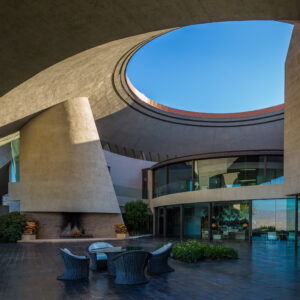Don’t worry I know how unoriginal exclamations of this sort are since Oswald Spengler’s prophecies. Unfortunately a rationale for such raw emotion is rarely provided by the authors. Thus I’ll make an attempt to bring some logic to it by comparing my beloved top architects in Palm Springs (which is pretty narrow field) to the Rock Music – an industry with billions of fans and enormous interest from the masses.
So let’s start. You can turn on Lenny Kravitz’s “Rock-n-Roll is dead” as a background. You’ll enjoy the ride. Lenny always delivers cool tunes.
Generally speaking from the Roman times there are two types of functioning systems: “Business” and “Show-business” (Romans fairly called it “Panem et circenses” – “Bread and circuses”). “Business” template works fine in industrial production, high-tech, banking, retail, constructions, energy and even science. It’s called capitalism. (Lately we might have a problem, but this would be a totally separate discussion). “Show-business” model works even better for all so called entertainment industries, primarily sport, cinema and music (gladiator fights in Rome). Prior to that, main entertainment industries were called Art. But the showbiz model works so well that no one seriously considers modern cinema or a pop-music to be an art. Nowadays showbiz is omnipotent. The rest are marginal occurrences (theatre, opera, arthouse cinema, independent labels, etc…) supported by the governments or private charities. That’s the basic structure of our society and there is no field of human activities that can escape fate of rapid commercialization and further glamorization of its substance. (I guess, TV ads are the apotheosis of it.)
STAIRWAY TO HEAVEN
As technical progress gained momentum architecture had no other choice but to move towards commercialized model. However at the very beginning it was different kind of business comparing to the conventional capitalistic template a-la Ford’s conveyor. Architect still was a highly respectable figure with influential individualistic position (think Mies or Frank Lloyd Wright) regardless to the fiscal returns. Architect’s major concern was creative design carefully balanced between the newest building science and traditionally accepted aesthetics.
Then the ideologies of mass-production and mass-consumption kicked in. It is pointless to discuss the objective necessity of it. Obviously, 20th century (wars, population growth, scientific developments, etc.) has required new ways for the development of architectural profession. Yet, I am not so convinced that chosen path that has transformed an Art of Architecture into the architectural business (a tedious mechanical business full of standards, licenses and bureaucracy) was the only answer to the challenges of time. Nevertheless as a result we have had a dull business environment (envisioned by Corbu’s dogmatic utopias) where architects were conducting orthodox business and people were getting dull boxes of orthogonal housing. On a public front it was even worse. After stylish innovative chic of Chicago School (Architecture was still an Art) and pseudo-classical yet impressive Fascist Architectonics (Architecture served dictators’ pride) ugly brutalism of 50s-70s with those over-scaled concrete monsters was a very explicable result. That was the price Architects paid for becoming businessmen.

